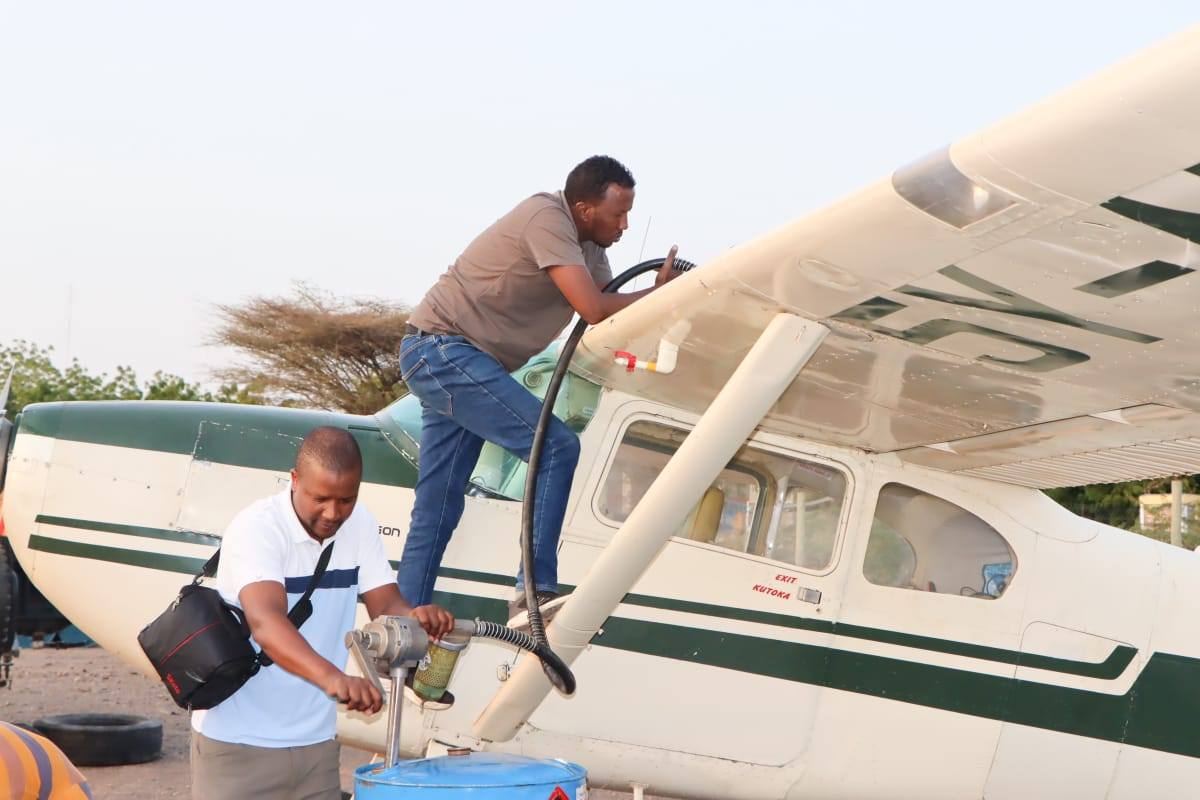

Census officials fuel a fixed-wing aircraft ahead of the exercise/WRTI
Kenya’s Second National Wildlife Census is now in its final
stages, with experts saying the exercise will provide one of the most
comprehensive pictures yet of the country’s wildlife populations.
Wildlife Research and Training Institute (WRTI) director Patrick Omondi described the current phase as particularly critical. “This phase will involve data analysis, development of species distribution maps and preparation of the final report, which will also integrate findings from independent studies on key species,” he said.
The census is being spearheaded by WRTI in collaboration with the State Department for Wildlife, Kenya Wildlife Service, the Directorate of Resource Surveys and Remote Sensing and other partners. It has been carried out in two phases covering some of the country’s most important wildlife landscapes.
The first phase spanned the Maasai Mara ecosystem, Amboseli-Magadi ecosystem, Naivasha-Nakuru ranches, Mwea National Reserve, Solio Conservancy, as well as Ruma and Nakuru national parks.
The second phase extended to the Laikipia-Samburu-Marsabit-Isiolo ecosystem, the Tsavo ecosystem, Turkana’s Nasalot, Garissa and Wajir counties, the Lamu and Tana River ecosystem, Shimba Hills National Reserve and Sibiloi and Lake Turkana national parks.
Kenya conducts a national wildlife census every three years to monitor populations, habitats and migration patterns. The last one, undertaken in 2021, revealed encouraging increases in special species including lions, giraffes, elephants, Grevy’s zebras and rhinos.
Omondi expressed gratitude to those who took part in the massive undertaking. “From the pilots, ground crew, data crew, to our front seat observers and rear seat observers, your dedication and professionalism have been the driving force behind the success of this census. I also thank all our partners and the Ministry of Tourism and Wildlife under the leadership of Cabinet Secretary Rebecca Miano and Principal Secretary Silvia Museiya,” he said.
The upcoming report, expected in September, will present not only the current status of wildlife populations but also historical perspectives on population trends. It will highlight the status of endangered and threatened species, providing crucial insights for policymakers and conservation agencies.
“This long-term outlook will be invaluable in helping policy makers, conservation agencies and communities understand population changes over time and implement proactive measures,” Omondi said. He added that the report will integrate data from multiple agencies to ensure it is scientifically rigorous, comprehensive and aligned with the government’s Bottom-up Economic Transformation Agenda.
“Ultimately, this report will be a strategic tool that empowers government, conservancies and community-based organisations to align their interventions with real-time, credible data. This evidence-based approach is central to ensuring that wildlife and people continue to coexist in harmony, while securing Kenya’s natural heritage for generations to come,” he said.
Some of the partners involved in the exercise include Save the Elephants, the Born Free Foundation, Kenya Institute of Primate Research, Grevy’s Zebra Trust, and the National Museums of Kenya.
The Second National Wildlife Census builds on the 2021 exercise, which cost Sh250 million and provided baseline numbers of Kenya’s wildlife. That census recorded 36,280 elephants, 897 black rhinos, 842 white rhinos, two northern white rhinos, 2,589 lions, 5,189 hyenas, 1,160 cheetahs, 865 wild dogs and 41,659 buffalo.
Other species counted included 13,530 Maasai giraffes, 19,725 reticulated giraffes, 938 Nubian giraffes, 121,911 common zebras, 2,649 Grevy’s zebras, 13,581 elands, 7,332 hartebeests, 57,813 wildebeests and 66,709 Grant’s gazelles.
But the census also comes against a backdrop of environmental stress. The prolonged drought of 2022 devastated wildlife across the country, particularly in Amboseli, Tsavo and Laikipia-Samburu ecosystems. A WRTI report released in November 2022 showed more than 1,000 animal deaths caused by lack of water and forage, with wildebeests, zebras, elephants, Grevy’s zebras and buffalo among the hardest hit.
With the new census report now nearing completion, conservationists and policymakers are waiting for insights that will shape future interventions. For Omondi, the goal is clear: to use solid, evidence-based data not just to count Kenya’s wildlife, but to secure its survival in an era of mounting threats.
















